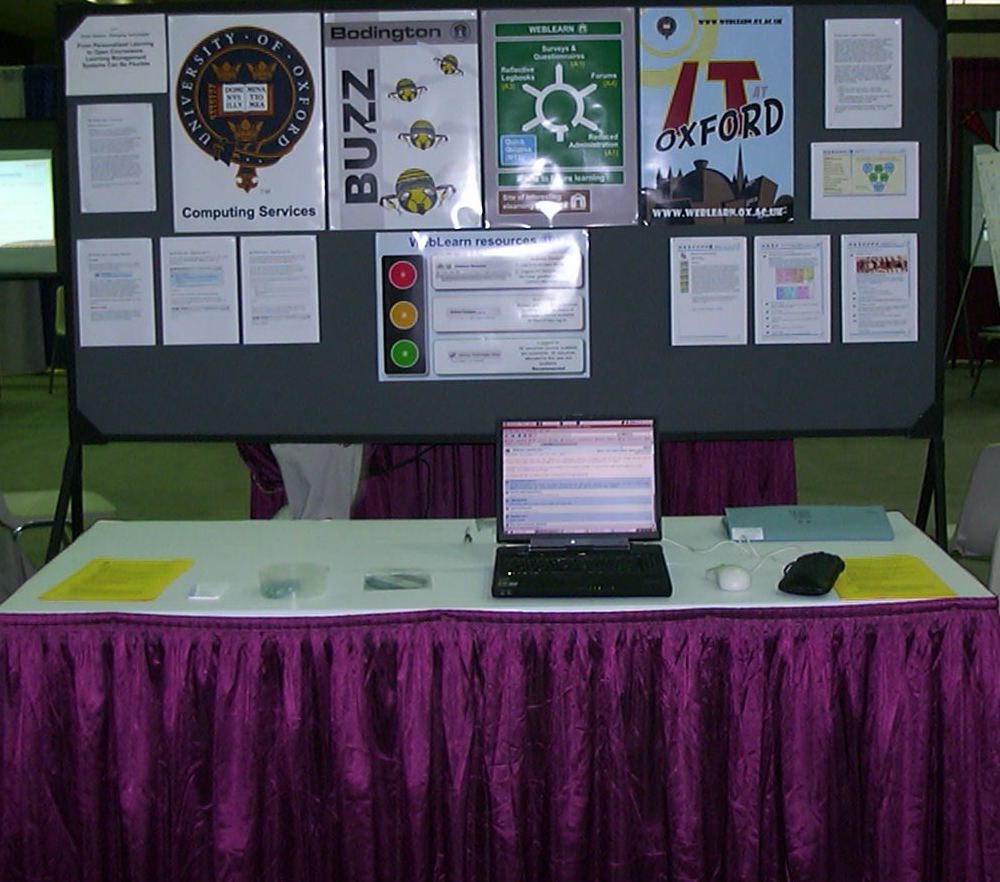I’ve seen e-learning from many angles — from procurement through to research and development to operational management and support. I then experienced such systems from the other side as a full-time student (again!). Whilst not presently having a formal institutional role in this area, I’ve continued with independent research, working with international partners.
Personalised Learning
My interest in personalised learning developed whilst carrying out research into mobile and ubiquitous computing. A great deal of attention, with substantial Government funding, was provided for a few years from the mid-2000s. It generated considerable optimism that the quality of learner support would be transformed, that learning would become a more relevant and meaningful experience. It was a period of notable innovation; in 2004-5, the RAMBLE project established a viable linkage between personal reflective spaces and institutional learning environments.
Reference: PLE Position Paper: PLEs as Environments for Personal and Personalised Learning
A few years later, elements of personalisation were being considered in making e-maths portable. By that time, priorities changed and these hopes of transformation faded in the subsequent decade. However, the Covid-19 pandemic has highlighted the limitations of existing educational structures centred on the national curriculum and a classroom-based didactic model. Many reports indicate that it has proven inflexible and many learners have not fared well. It has opened up renewed attention in personalised learning and so this is an area to which I returned to in 2021, when for a few months I was a core team member in a collaboration to produce a novel recommender system.
KEPLAIR Project
KEPLAIR (Knowledge-based Environment for Personalised Learning using an Artificial Intelligence Recommender) is a project that squarely places the responsibility of learning on the individual, providing them with a far-reaching companion for lifelong learning.
In the early stages of a start-up, my role was varied from some research of e-learning systems to day-to-day project support, including the establishment of Zotero as the shared reference management system (from which, incidentally, the items in the publications page is generated).
Project site: http://keplair.info/
EDULEARN21 paper: Introducing KEPLAIR: A Platform for
Independent Learners
E-Learning and Virtual Learning Environments
For almost a decade, I specialised in Virtual Learning Environments (VLEs), also known as Learning Management Systems (LMS). Most of my experiences was gained at Oxford University Computing Services (see below), after which I was able to have a good overview of both the technology, including the integration of corporates systems such as student records, and more general organisational issues. I have expressed some of these experiences in a co-authored paper, An Introduction to Virtual Learning Environments (PDF) by P.Trafford and Y. Shirota, Gakushuin Economic Papers, October 2011.
I have also been engaged more specifically in
mathematics e-learning systems, particularly for
undergraduates in business and management who
haven’t studied much advanced maths in secondary
school. Some notes below. My current interest in
the architecture of
social networking sites would also merit study
with some particular facets in the context of
learning that could be developed as its own
branch.
Mathematics e-Learning
I have undertaken some joint research with Professor Yukari Shirota at the Faculty of Economics, Gakushuin University, in Tokyo. Prof. Shirota has been deploying computer algebra systems aided by Web-based visualization tools to help students’ problem-solving ability. My input concerns the presentation of mathematical materials for the Web, especially with a view to targeting mobile devices, which students can use to review multimedia feedback. This led to a research visit in July 2011. Whilst in Gakushuin University, I gave a class on Game Theory.
- Trafford P. and Shirota Y. 2011. Requirements for Business Mathematics e-Learning System “How2SolveIt”, presented at Japan Society of Business Mathematics annual conference, June 2011.
- Trafford P. and Shirota Y. 2011. Ubiquitous e-Learning: Designing Web Systems for Economics and Business Mathematics, Gakushuin Economic papers, Vol.48, No.2, pp. 111-128. It is available in HTML and PDF formats.
- A class in Game Theory for Management students — a blog post sharing what was for me a rare teaching experience!
VLE work at OUCS
I worked at Oxford University Computing Services (OUCS) between 2000 and 2008; the VLE was a recurrent theme from the interview until I left. When I arrived (at the then Humanities Computing Unit) I was asked to research and review various options for a departmental system, thereby introducing myself to some educational background, characteristics of tools and some of the intricacies of Oxford’s educational structures!

At OUCS I was based in the Learning Technologies Group — generally found in the North end of the building. The main themes concern e-learning, virtual learning environments, Web development, handheld and mobile computing. The photo above is from a large Education/IT conference called Educause (it dwarfs any other HEI conference I’ve attended!)

Between December 2002 and August 2008, I acted as ‘VLE Administrator’, looking after the day-to-day running of WebLearn, a centrally hosted service available to staff and students here, myself included. At that time it was using as its underlying framework the Bodington open source software. Since then a new system has been adopted called Sakai, which has been augmented with some of the key architectural features of Bodington, and the VLE have since been engaged in the migration process.
The range of responsibilities covered Linux system administration, VLE administration (mainly data mining of the database through Perl/SQL), Web-based admin of the VLE, support for more than 100 other Admins of the VLE, help desk, marketing, training, presentations. My Educause Connect blog (plus earlier entries) [archive] contains some brief reports on aspects of my work, which could cover anything from routine tasks to brief investigations of particular technologies and services.
In parallel to the VLE work, I investigated other complementary tools and services such as blogs and wikis, driven in large part by experiences from the RAMBLE project. This led on to consideration of ‘PLEs’ – which can be taken to stand for ‘Personal Learning Environments.’ It’s a contentious area! Generally, I’ve been quite active in promoting open ways of working, a natural part of which is open source software. I’m hoping that this can pervade more my interest in mobile learning.
Open Courseware and Open Educational Resources
The Bodington software provides considerable flexibility, with a particular strength being its devolved hierarchy and access rights system. These have since been incorporated into Sakai, so I expect that many of WebLearn’s resources continue to remain freely available and indexed by Google – no login required. At the same time, WebLearn provides for each user a personal space in which almost all the tools can be used. This prompted me to consider Open courseware, the original conception of which was MIT’s OpenCourseWare (OCW). Since my initial forways, there has been considerable interest at large in the general subject of open educational resources, which have focused in particular on multimedia.
However, OCW is known to be expensive. After some reflection, it occurred to me that many aspects of Bodington show an organic way towards solving the problem. The following order is deliberate (not chronological)
- From Personalized Learning to Open Courseware: VLEs and Access Rights. This authorisation infrastructure, which has been recognised by others (see e.g. Michael Feldstein’s posts reviewing Bodington – Part 1, Part 2). This granularity in design is, I think, key to the technical facilitation, with wider implications in Web2.0.
- Open Courseware in a few clicks — illustrating the mechanism that Bodington offers to very quickly release something to the open. However, it doesn’t address the licensing issue!.
- Post poster reflections: openness and open courseware — in which I identify some barriers to broad adoption of open courseware
- The quest for sustainability in open courseware — seeks a bottom-up organic approach, but still operating within the institutional domain.
Web2.0-related articles
- PLEs meeting: Questions, many more questions, and a little more focus. Notes from a JISC CETIS meeting on PLEs
- PLEs as Environments for Personal and Personalised Learning (mini position paper) – I argue for letting ‘PLE’ retain a meaning independent of systems and technology.
- All aboard? Reflections on the 7th Sakai conference, Amsterdam — Sakai is gradually shedding its image as a developer-led alternative to Blackboard; I felt a sense of a growing and more widely participative community. I still have my doubts over its design w.r.t. Oxford’s needs, but strong progress is definitely being made.
- The End of the LMS? Web 2.0: Preparing for a New Focus in E-Learning. [Slides are available (probably too many!)]. Paul Davis and I delivered this preconference seminar at EDUCAUSE 2007. We’ve identified some recurrrent themes, key questions, and a flexible process to evaluate blogs, wikis etc. There’s no magic wand, though.
Tags
artificial intelligence, courseware, e-maths, education, learning, LMS, mathematics, mobile, OER, pedagogy, personalised learning, PLE, VLE
This page was published on 9 April 2016 and last updated on September 25, 2022.